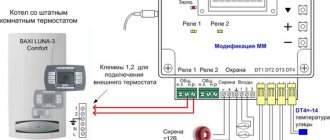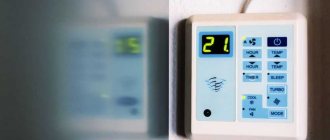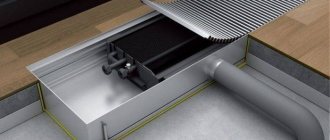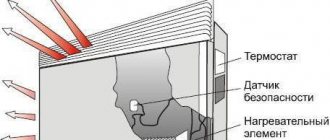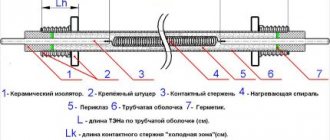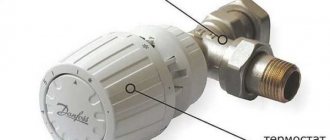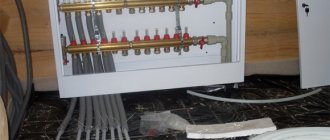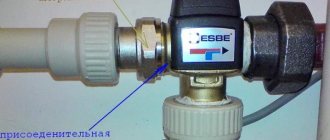A thermostat is a device that allows you to maintain the temperature within specified parameters.
Below you will learn how a thermostat works, how it works and the basic principle of its operation. Without noticing this, we often come across a thermostat in life: it makes sure that the refrigerator maintains the desired temperature, does not overheat or freeze, thanks to it the kettle is heated to the desired temperature, and the car quickly warms up and does not break down due to the high engine temperature . You will learn why a thermostat is needed in different devices and what needs to be done to identify faults.
Heating thermostat
About 30 years ago, special devices began to be used in the heating system, with the help of which it is possible to control the temperature conditions indoors. Heating thermostats - that’s what these devices are called. They have become an integral part of any heating system, regardless of the purpose of the room where it is used.
Using thermostats, you can not only regulate the flow and temperature of the coolant in heating radiators, but also, if necessary, completely shut off the flow to the radiator. This makes it easier to repair or replace the device, since there is no need to stop the entire heating process and completely drain the coolant. Therefore, installing a thermostat is a very profitable investment.
Without exception, all thermostats have the same design and the same operating principle. The only difference is the way the device is controlled.
Heating thermostat
A mechanical or, as it is also called, a manual heating thermostat has a temperature gradation on the valve. If you need to change the temperature inside the room, you just need to turn the handle in one direction or the other. Here it is important to accurately catch the required division. Sometimes this has to be determined empirically.
Typical symptoms of malfunction
Motorists may notice problems with this unit based on the following signs.
- The motor heats up too quickly.
- The temperature rises to normal for too long.
- During the trip, the motor needle drops, and it rises when braking.
To identify defects, it is recommended to monitor all parameters of each part and arrive on time for professional diagnostics. Computer technology will help identify the slightest problems at an early stage, preventing the replacement of the device and extending the service life of your favorite “swallow”. It is worth listening to the recommendations of specialists in service centers, contacting serious auto repair shops with a license, good material and technical resources, and experienced craftsmen who understand the intricacies of technical devices.
Room thermostat for heating device
A room thermostat is an automatic device whose task is to regulate the temperature of a heating device. The device monitors the room air temperature and, if necessary, sends a signal to the boiler to increase or decrease its power. Typically, boilers are equipped with built-in programmers, but in some cases additional devices need to be connected separately.
Temperature regulator, remote
Is it possible to handle the replacement yourself?
With the development of Internet resources, there are no problems in finding guides for replacing individual spare parts. If you want to replace the thermostat yourself, you need to get a sealant, a Phillips screwdriver, a basin for draining the coolant, and keys for “12” and “13”. Essentially, the replacement involves the following: drain the antifreeze, remove the decorative engine cover, disconnect the thermostat housing, remove the thermostat and install a new one. Often thermostats are designed in such a way that the side on which you install it matters. For ease of identification, the manufacturer makes marks such as “Front” and “Rad”, or an arrow pointing to the radiator. We recommend that you also change the clamps and seals during installation. After replacement, it is recommended to add antifreeze and ensure there are no leaks.
Types of thermostats
Room thermostats are qualified by installation method, functionality, and technical design.
According to the installation method, they are distinguished:
- Wired thermostats, where contacts between blocks are maintained through wires. The advantage of such devices is the ability to transmit data to remote locations (further than 50 meters). The household electrical network is usually used as a power source.
- Wireless thermostats, where communications between the controller and the executive unit are carried out using periodic signals. The advantage of wireless technologies is that there is no need to make holes for wires. The main disadvantage: reinforced concrete walls greatly reduce the signal power and limit the working radius of the device.
Room thermostats for boilers do not create a harmful electromagnetic field, but only periodically transmit a low-power pulse. In addition to safety, this solution makes it possible to save battery power.
According to functionality, thermostats are classified into:
- simple ones that hold the desired temperature
- programmable, where it is possible to set the desired mode for a week in advance (accurate to the minute)
According to technical design, thermostats are divided into:
- electronic
- electromechanical
- mechanical
Purpose
A capillary thermostat is used to control the temperature. Used as a relay in household appliances, industry, to ensure safety in case of fire.
This device can be used as a double-acting thermostat. In the first case, the element can shut down various systems in the event of an increase in temperature. In the second case, he is able to turn off running systems, switching to ensuring the operation of other systems. For example, when the temperature rises, it can turn off appliances, heating elements and turn on the air conditioner or fan to cool the room. Also capable of triggering an alarm in case of fire. This element has many purposes, the main thing is how it is connected to the electrical circuit.
Let's take a closer look at the technical design
Electronic thermostats
An electronic room thermostat is based on three main components:
- temperature sensor
- signal transmitter
- thermostat
The main advantage of electronic thermostats is the accuracy of their work in identifying and adjusting the temperature regime in the room. This device is easy to control and can be used as part of a “smart home”.
Electromechanical thermostats
An electromechanical room thermostat is simpler in internal structure than an electronic one. The central element of the devices is the relay. This unit looks like a cylinder in the form of a tube, which is filled with a temperature-responsive substance. As soon as the boiler heats up, the substance expands. And vice versa: as the temperature decreases, the substance contracts. The drive reacts to changes in the substance and regulates the temperature using an electrical circuit.
Electromechanical thermostat
Mechanical thermostats
Mechanical type regulators are characterized by the absence of electronic filling. The operating principle of such thermostats is based on the ability of materials to change their properties under the influence of temperature. As a result of a change in the temperature regime of the substance in the gas membrane, the electrical circuit is closed or broken, which activates certain mechanisms of the equipment.
A room thermostat for a gas boiler (or any other) can be controlled mechanically or automatically. The degree of heating of the room is directly influenced by the temperature of the coolant. As soon as it heats up to the desired condition, the boiler turns off. When the temperature drops, it connects again. The response threshold differs in different systems, but in general it is 0.25 degrees.
The function of monitoring the operation of heating equipment is performed by the programmer. This device, in addition to the obvious convenience of automating the process, also performs another role - it allows you to save fuel. Indeed, in manual mode, the boiler often turns on and off, and the movement of the coolant is created by a pump that operates even when the heating system is turned off. The consequence of this is increased electricity consumption and reduced equipment life.
Note! The room thermostat responds not to the temperature of the coolant, but rather to the air temperature, as a result of which the number of boiler on-offs is reduced in comparison with manual adjustment. In other words, even if the batteries are already cold, but the air temperature in the room is at an acceptable level, the boiler will not turn on.
The boiler will also not turn on in some other situations:
- heating the room by the sun's rays
- decrease in temperature delta
- increase in the number of people in the room, etc.
The practice of using thermostats shows that they can save up to a third of thermal energy.
We carry out diagnostics ourselves.
Without removing the thermostat from the car, you can easily monitor its operation. We warm up the engine, and then touch the hose from the thermostat to the radiator. Its normal state is: low temperature, comparable to air temperature. If it is hot, then you should either go to a service station, or try to dismantle it and carry out further diagnostics yourself.
We remove the thermostat and check it
" This is done very simply: place a thermometer and thermostat in a pan with clean water. We heat the water, trying to fix its temperature at the thermometer mark of 90°C. If the thermostat valve begins to open slowly, there is no reason to worry. This did not happen or the valve did not open completely; an urgent replacement will have to be carried out.
Tips for installing and connecting thermostats
Installers advise installing thermostats in living rooms. Their installation in a corridor or boiler room leads to system disorientation and false alarms. It is recommended to choose the coolest room or where there are the most people.
No heat sources such as radiators or heaters should be located near the thermostat. The device should not be exposed to direct sunlight. It is necessary to avoid placing the thermostat in a draft. It is also undesirable to be near electrical appliances that emit thermal noise.
The boiler is turned on and off by a special relay. The thermostat is connected using a terminal on the boiler at a specified location or via a thermostat cable. The programmer requires batteries to operate.
Before connecting the room thermostat, you need to read the instructions, which are located in the technical data sheet of the device. Usually the passport has a separate section dedicated to connecting the thermostat.
About the causes of possible breakdowns
Any spare part is subject to wear and breakdown. A common cause of fluid failure to circulate is considered to be corrosion that damages the surface of the cylinder. Auto mechanics advise replacing the part once every two years. Poor-quality antifreeze leads to a violation of the tightness of the body where the wax is placed. As a result, the friction force of the rod increases. A long delay of the power unit at idle for more than 10 minutes leads to rapid failure of this working part. What do experts advise to reduce the risk of damage?
Some tips when purchasing
If you decide to buy a mechanical, electronic or electromechanical room thermostat for the boiler, it is advisable to adhere to the following recommendations:
- It is worth choosing a thermostat from the same company that manufactured the boiler. This will ensure greater compatibility and easier installation.
- When purchasing a device, you should take into account the area of the room and the desired temperature conditions.
- To reduce heat loss, it is necessary to insulate the room
A brief tour of brands
As experts can advise you, it is better to buy original thermostats from well-known manufacturers. Otherwise they are called OEM spare parts. Their prices are high, but the spare part itself can serve for many years without a single misfire.
The following companies have products of the highest level: Mahle, Behr, Wahler (Germany), Valeo (France).
Some of the most popular brands are: Gates (USA), Febi, Meyle, SWAG (Germany), Facet (Italy), Calorstat by Vernet (France). The quality of the products is very high, the prices are not bad. By the way, in Ukraine and Russia these brands are widely known and in great demand.
Among the budget solutions, it is worth noting the following two companies: Starline (Czech Republic), JP Group (Denmark). The prices are very affordable, but the products themselves meet all quality standards.
You should avoid thermostats from little-known companies that have recently entered the market. The reason is simple: there is a high risk of stumbling upon counterfeit products that look almost no different from thermostats from large companies, but are inferior to them in absolutely everything.
Model overview
Capillary thermostats for domestic use must be reliable, durable, and have a simple connection diagram. Next, a description of the 3 most suitable thermostats for domestic use will be given.
AZT-6
Mechanical thermostat. Main purpose: temperature control of water heaters. The device is equipped only with a knob for adjusting the operating temperature. Operates in modes - 15 + 85 degrees C.
Among the advantages:
- Easy to connect.
- Fast cut-off.
- Miniature appearance.
- Low price.
AZT-6 is an excellent assistant for monitoring air temperature changes in the house.
Ballu BMT-2
Temperature controller for heaters and ventilation systems. Operating range +5–35 °C. The device is used to switch between heating devices and ventilation systems. Has a built-in notification about changing the operating mode. Can be used to connect 4 devices at once into a common system, with their subsequent division according to temperature conditions.
Pros:
- High reliability.
- Ease of Management.
- Multiple connection pairs.
- Not a high price.
The Ballu BMT-2 regulator can be trusted to control the temperature in the house with an electrical load of more than 10 amperes.
Terneo EG
The device is designed to control the temperature in the incubator. The model is completely electronic. Has an additional socket on the body. Working in incubators is not the only purpose of this model. It can be used for work in warehouses and basements.
Pros:
- Easy setup of parameters.
- Easy to read display.
- Availability of sound notification about operation.
- Additional socket.
Terneo EG is very reliable. Through this device, you can connect several devices and set the response temperature for each device.
Principle of operation
The operating principle of a capillary thermostat is very simple. First you need to understand what it is and what the device consists of. The element consists of the following parts:
- Capillary flask made of copper or brass.
- Tubes made of the same materials.
- Diaphragm regulator with electrical contacts.
- Gas or liquid in a flask.
A capillary tube thermostat operates using the principle of pressure from an expanding fluid. The sealed flask contains a liquid whose density is less than that of ordinary water. The flask is soldered to a tube, which in turn is attached to a membrane on the mechanical part of the capillary thermostat. When the temperature increases above 3 degrees, the liquid begins to expand, creating pressure on the surface of the adjustable membrane. After overcoming the elasticity value, the membrane is activated, opening the electrical contacts of the regulator. Depending on the settings, the regulator can operate at temperatures from + 3 to +40 degrees. It all depends on where the capillary thermostat is used.
Scope of application
The capillary thermostat is a very common temperature sensor. It is often used in:
- Household instrument making. The element is installed in air conditioners, furnaces, water heating boilers, washing and dishwashing appliances, and ventilation systems of “Smart” homes.
- In industry, this mechanism is used to control the temperature of gases and liquids. Used for ventilation of rooms. There are devices for monitoring the temperature of electric motors that are operated without human supervision.
- Before the invention of fire and smoke detectors, thermostats with a capillary system were used as temperature controllers in warehouses and unguarded premises.
As mentioned earlier, this mechanism can be included in the electrical circuit of almost any device.
